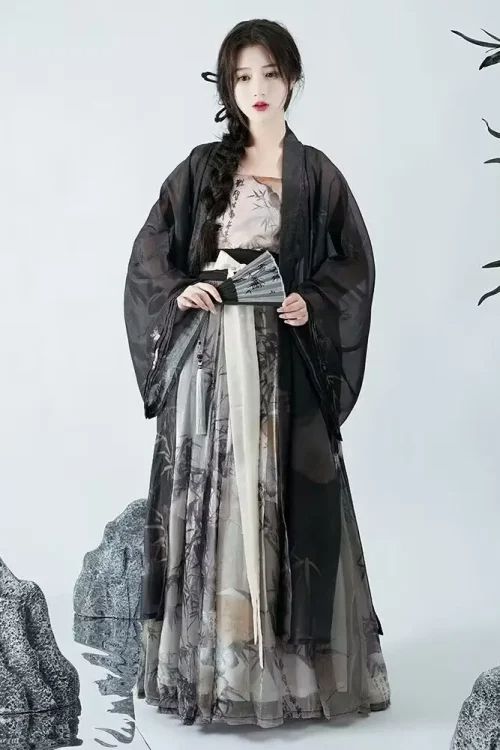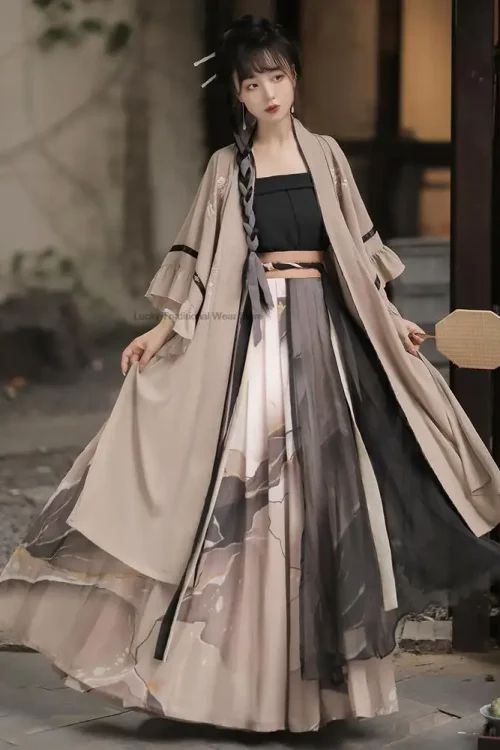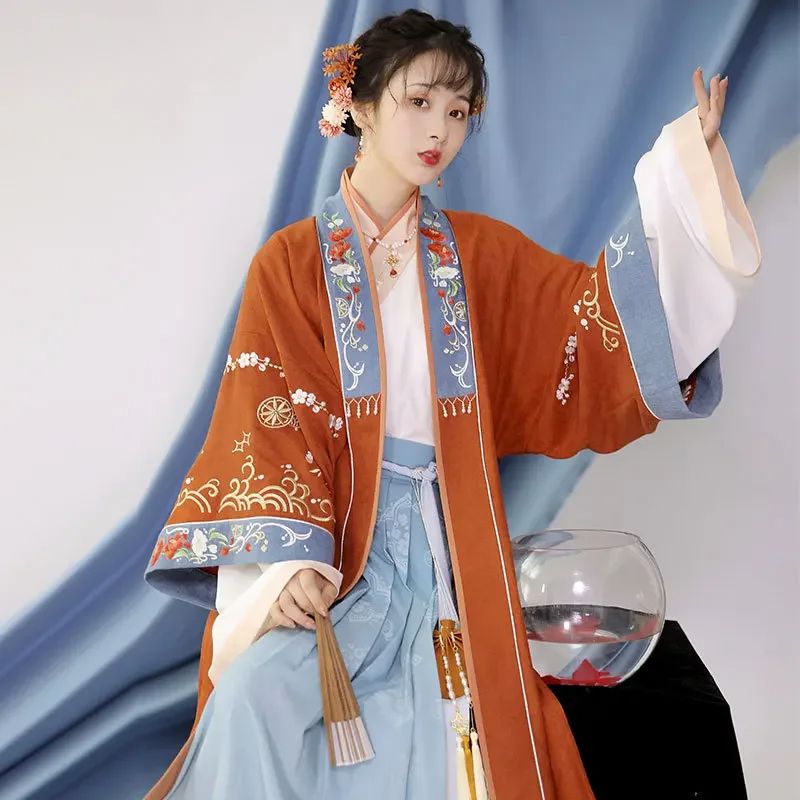The Evolution of Gender Roles in Song Dynasty Hanfu
In the Song Dynasty, Hanfu, the traditional Chinese clothing, played a significant role in shaping gender roles and social norms. During this period, Hanfu underwent significant changes that reflected the evolving societal attitudes towards gender.

Initial Gender Neutrality in Hanfu
Initially, Hanfu was relatively gender-neutral, with both men and women wearing similar garments. However, as the Song Dynasty progressed, distinct gender roles emerged, and Hanfu became a means of expressing these differences. Men’s Hanfu became more formal and structured, emphasizing their authority and status. Women’s Hanfu, on the other hand, became more elaborate and decorative, reflecting their domestic and nurturing roles.
Color Symbolism in Hanfu
The use of color in Hanfu also reinforced gender distinctions. Men typically wore darker colors, such as black, blue, and brown, which symbolized strength and power. Women, in contrast, wore brighter colors, such as red, pink, and yellow, which represented beauty and femininity.
Differences in Length and Style
Furthermore, the length and style of Hanfu varied according to gender. Men’s Hanfu was generally shorter, allowing for greater mobility and freedom of movement. Women’s Hanfu, on the other hand, was longer and more flowing, emphasizing their modesty and grace.
Influence on Social Behavior
The evolution of Hanfu in the Song Dynasty not only reflected changing gender roles but also influenced social behavior. The distinct clothing styles reinforced the expectations and limitations placed on men and women. Men were expected to be strong, assertive, and active, while women were expected to be gentle, submissive, and domestic.
Challenging Traditional Norms
However, it is important to note that these gender roles were not always strictly enforced. There were instances of women who defied societal norms and adopted more masculine attire, such as the renowned poet Li Qingzhao. Similarly, some men chose to wear more feminine garments, expressing their individuality and challenging traditional gender boundaries.
Conclusion
In conclusion, Hanfu in the Song Dynasty was a powerful cultural artifact that shaped gender roles and social norms. The distinct clothing styles, colors, and lengths reflected the evolving societal attitudes towards men and women. While these gender roles were generally reinforced through Hanfu, there were also instances of individuals who challenged these norms, demonstrating the fluidity and complexity of gender identity in Chinese history.
Hanfu as a Reflection of Social Hierarchy and Gender Norms
In the Song Dynasty, Hanfu, the traditional Chinese clothing, played a significant role in reflecting social hierarchy and gender norms. The intricate designs and elaborate fabrics of Hanfu denoted the wearer’s status and position within society.

Women’s Hanfu: Modesty and Propriety
For women, Hanfu served as a symbol of modesty and propriety. The garments were typically long and flowing, covering the body from head to toe. The sleeves were often wide and loose, allowing for freedom of movement while maintaining a sense of elegance. Women’s Hanfu also featured intricate embroidery and embellishments, which varied depending on the wearer’s social rank.
Men’s Hanfu: Practicality and Authority
In contrast, men’s Hanfu was more tailored and practical. The garments were shorter and fitted, allowing for greater mobility. The sleeves were narrower and often cuffed, providing a more formal appearance. Men’s Hanfu also featured simpler designs and fewer embellishments, reflecting the more active and public roles that men typically held in society.
Symbolic Colors in Hanfu
The colors of Hanfu also carried symbolic meaning. Bright and vibrant colors, such as red and yellow, were reserved for high-ranking officials and members of the imperial family. More subdued colors, such as blue and green, were worn by commoners and lower-ranking officials.
Reinforcement of Gender Roles
Beyond its aesthetic significance, Hanfu also played a practical role in reinforcing gender roles. The long and flowing garments worn by women restricted their movement and limited their participation in certain activities. This served to reinforce the traditional view that women should be confined to the domestic sphere.
Active Roles for Men
In contrast, the more tailored and practical garments worn by men allowed them greater freedom of movement and facilitated their participation in public life. This reflected the societal expectation that men should be active and engaged in the affairs of the world.
Cultural Significance of Wearing Hanfu
The gendered nature of Hanfu extended beyond its design and function. The act of wearing Hanfu itself was imbued with cultural significance. For women, it was a symbol of their virtue and chastity. For men, it was a mark of their authority and status.
Conclusion
In conclusion, Hanfu in the Song Dynasty was not merely a form of clothing but a powerful reflection of social hierarchy and gender norms. The intricate designs, elaborate fabrics, and symbolic colors of Hanfu served to reinforce the traditional roles and expectations of men and women in society.
The Influence of Confucianism on Gender Roles and Hanfu in the Song Dynasty
During the Song Dynasty (960-1279), Confucianism played a pivotal role in shaping gender roles and influencing the development of Hanfu, the traditional Chinese clothing. Confucianism emphasized the importance of social hierarchy and gender distinctions, which were reflected in the design and usage of Hanfu.

Women’s Role in Confucianism
For women, Confucianism prescribed a strict code of conduct known as “sancong sidde,” which dictated that they should obey their fathers, husbands, and sons. This subordination was reflected in their Hanfu, which was typically modest and covered most of their bodies. Women’s Hanfu often featured long, flowing sleeves and skirts, symbolizing their domesticity and virtue.
Men’s Dominance in Society
In contrast, men were expected to be the dominant figures in society. Their Hanfu reflected this status, being more elaborate and often adorned with symbols of power and authority. Men’s Hanfu typically consisted of a long robe called a “changpao” and a wide belt called a “daidai.” The changpao was often decorated with intricate embroidery or patterns, while the daidai served as a symbol of their official rank.
Movement and Participation
The division of gender roles in Hanfu extended beyond the physical appearance. Women’s Hanfu was designed to restrict their movement and limit their participation in public life. Men’s Hanfu, on the other hand, allowed for greater freedom of movement and symbolized their active role in society.
Gradual Changes in Gender Roles
However, it is important to note that the influence of Confucianism on Hanfu was not absolute. During the Song Dynasty, there was a growing trend towards greater gender equality, particularly among the elite. This was reflected in the emergence of new styles of Hanfu that allowed women more freedom of expression and movement.
Artistic Flourishing and Hanfu Development
Furthermore, the Song Dynasty witnessed a flourishing of artistic and cultural activities, which influenced the development of Hanfu. Artists and scholars began to experiment with new designs and materials, creating Hanfu that was both aesthetically pleasing and reflective of the changing social norms.
Conclusion
In conclusion, the gender roles and Hanfu of the Song Dynasty were deeply influenced by Confucianism. Confucianism prescribed strict gender distinctions that were reflected in the design and usage of Hanfu. However, the influence of Confucianism was not static, and the changing social and cultural landscape of the Song Dynasty led to a gradual evolution in both gender roles and Hanfu.
